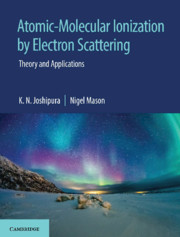Book contents
- Frontmatter
- Dedication
- Contents
- List of Figures
- List of Tables
- Foreword I
- Foreword II
- Preface
- Acknowledgments
- 1 Atoms and Molecules as Bound Quantum Systems
- 2 Quantum Scattering Theories
- 3 Electron Atom Scattering and Ionization
- 4 Electron Molecule Scattering and Ionization – I: Small Molecules and Radicals
- 5 Electron Molecule Scattering and Ionization – II: Other Polyatomic Molecules and Radicals
- 6 Applications of Electron Scattering
- Bibliography
- Index
Foreword II
Published online by Cambridge University Press: 20 December 2018
- Frontmatter
- Dedication
- Contents
- List of Figures
- List of Tables
- Foreword I
- Foreword II
- Preface
- Acknowledgments
- 1 Atoms and Molecules as Bound Quantum Systems
- 2 Quantum Scattering Theories
- 3 Electron Atom Scattering and Ionization
- 4 Electron Molecule Scattering and Ionization – I: Small Molecules and Radicals
- 5 Electron Molecule Scattering and Ionization – II: Other Polyatomic Molecules and Radicals
- 6 Applications of Electron Scattering
- Bibliography
- Index
Summary
To study any system, an interaction with the system is essential. For microscopic objects and systems, which cannot be seen by the naked eye, usually the electron (or photon) beam, with known characteristics, acts as the probe. At a micro-distance, the projectile particles interact/collide with the object and subsequently they are scattered in all possible directions. The scattered particles, electrons in our case, carry the signature of interaction with the object (target). Hence, the measurement of the differential cross sections, I(, O) over all possible directions, yields the total collisional cross section (Ei) as a function of the incident energy Ei of the electrons. For the atomic targets, the collisions are elastic as well as inelastic, including ionization. For the molecules, the additional processes like dissociation and the dissociative ionization, etc., are also possible. Besides, the dissociative components may be in the excited state. Myriad phenomena arising out of electron scattering make the study very interesting from the manifold view-points of theory, experiment, as well as applications.
In the present book, written by Professors K. N. Joshipura and Nigel Mason, collisions of electrons with atoms are briefly discussed initially. In the greater part of the book, molecules are considered as targets. The study is extended to the radicals and the metastable molecules, while a few molecules of biological interest are also considered. The applications of various scattering cross sections to diverse fields like astrophysics, astrochemistry, nanotechnology, etc., are described in the last chapter.
Both the authors are experienced players in the field of electron–atom–molecule collisions. They have a good number of publications to their credit. From the theory as well as application point of view the present book should be quite useful.
- Type
- Chapter
- Information
- Atomic-Molecular Ionization by Electron ScatteringTheory and Applications, pp. xxv - xxviPublisher: Cambridge University PressPrint publication year: 2019

